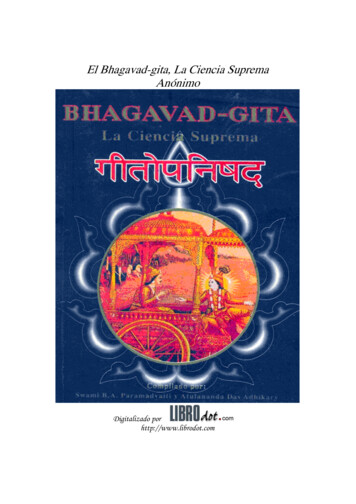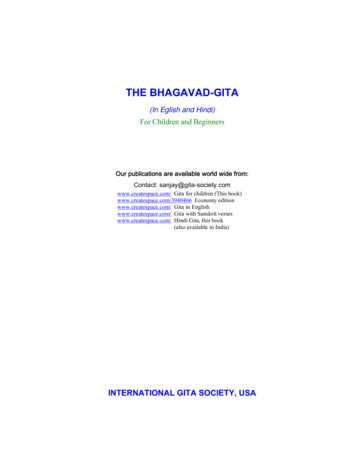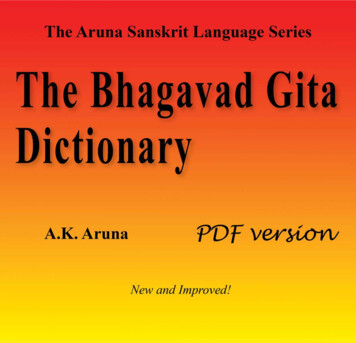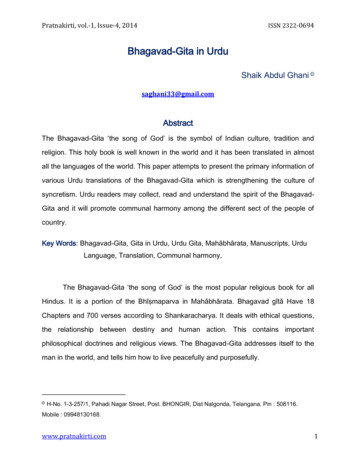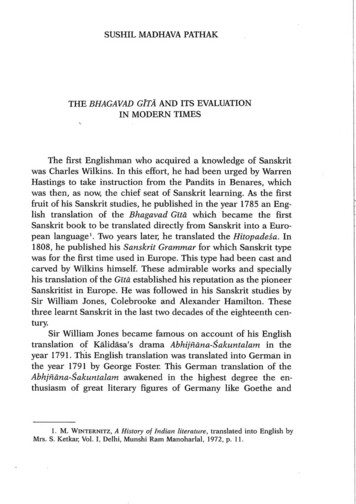
Transcription
SUSHIL MADHAVA PATHAKTHE BHAGAVAD GITA AND ITS EVALUATIONIN MODERN TIMESThe first Englishman who acquired a knowledge of Sanskritwas Charles Wilkins. In this effort, he had been urged by WarrenHastings to take instruction from the Pandits in Benares, whichwas then, as now, the chief seat of Sanskrit learning. As the firstfruit of his Sanskrit studies, he published in the year 1785 an English translation of the Bhagavad Gita which became the firstSanskrit book to be translated directly from Sanskrit into a European language'. Two years later, he translated the Hitopadeéga. In1808, he published his Sanskrit Grammar for which Sanskrit typewas for the first time used in Europe. This type had been cast andcarved by Wilkins himself. These admirable works and speciallyhis translation of the Gita established his reputation as the pioneerSanskritist in Europe. He was followed in his Sanskrit studies bySir William Jones, Colebrooke and Alexander Hamilton. Thesethree learnt Sanskrit in the last two decades of the eighteenth century.Sir William Jones became famous on account of his Englishtranslation of Kalidasa’s drama Abhijfidna-Sakuntalam in theyear 1791. This English translation was translated into German inthe year 1791 by George Foster. This German translation of theAbhjfana-Sakuntalam awakened in the highest degree the enthusiasm of great literary figures of Germany like Goethe and1, M. WINTERNITZ, A History of Indian literature, translated into English byMrs. S. Ketkar, Vol. I, Delhi, Munshi Ram Manoharlal,1972, p. 11.
292Sushil Madhava Pathak“Herder?, Sir Jones was also the founder of the Asiatic Society ofBengal which greatly promoted Oriental learning. In 1794, SirJones translated the Manusmrti into English entitled the Ordinance of Manu. H.T. Colebrooke was the father of Indian Philology and Archaeology? His interests lay not so much in the poeticas in the scientific side of Sanskrit literature. He contributed pioneer essays on Indian Philology and religion, grammar, astronomyand arithmetic of India, in Europe*. Alexander Hamilton returnedto England in 1802. Travelling through France he was detained inParis under orders from Emperor Napoleon. In the year 1802, theGerman poet Friedrich Schlegel had also just come to Paris to staythere till the year 1807. When he made the acquaintance of Alexander Hamilton in Paris, Friedrich Schlegel at once seized theopportunity. oflearning Sanskrit from him. He also utilized his stayabout two hundred Manuscripts. As a result of these studies,Friedrich Schlegel became the founder of Indian Philology inGermany. He published his first book on Indian Philology in 1808entitled Uber die Sprache Und Weisheit der Inder, which containedtranslations of some passages from the Ramayana, Manusmrti, theBhagavad Gita and from Sakuntala episode of the Mahabharata’.These were the first translations from Sanskrit into German.It was August Wilhelm Von Schlegel, Schlegel’s brother, whowas the first in Germany to develop an extensive activity as a Sanskrit scholar by editing texts, translations and other philologicalworks. He was also the first Professor of Sanskrit in Germany* August Schlegel also learnt Sanskrit in Paris in 1814 from a FrenchmanA.L. Chezy, who was the first French scholar to learn andteach Sanskrit as well as the first Professor of Sanskrit at the Collegede France’. In the year 1823, August Schlegel published the first vo-Ibid. Ibid., p. 22.Ibid.Ibid.Ibid.WawISO. Ibid.
The Bhagavad Gita and its evaluation in modern times293lume of the periodical «Indische Bibliothek», containing numerousessays on Indian Philology. In the same year he also published agood edition of the Bhagavad Gita with a latin translation . Anotherscholar who showed enthusiasm for Sanskrit studies during thisperiod was Wilhelm Von Humboldt. In the year 1821, he began tolearn Sanskrit because he looked upon the study of Sanskrit as thekey to philological studies. Schlegel’s edition of the Bhagavad Gitahad directed Humboldt’s attention to this poem. He devoted special treatises to it and in its appreciation he wrote to his friendFrederick Von Gentz in 1827.«It is perhaps the deepest and loftiest thing the world has toshow»’.Hegel (1770-1831), the German Philosopher welcomed Wilhelm Von Humboldt’s essays on the Bhagavad Gita and replied tothem in 1827 with two very extensive reviews which revealed hishighly critical attitude towards the Gita. In his view, Hinduism isthe most typical and most illustrative example of the «religions ofsubstance». There is an immense sublimity and grandeur in theidea of Brahman — but it remains negative with regard to theparticularities of the Finite World .The Absolute, be it Brahman or Krishna of the Gita is eitherprinciple of an abstract negation of the finite or principle of anabstract combination of negation and identification. The DivineBeing of the Gita is discovered in all finite beings; it permeatesthem — but only as their indeterminate self-identity, as the « Beingof their existence». The «immanence» of God in the World and the«immanence» of the World in God, remains the immanence of theabstract in the abstract!'.Hegel further criticised the idea of Moksha as an abstract and negative liberation'*. Hegel also failed to appreciate the Philosophy8. Ibid., p. 16.9. Indische Bibliotheck, Vol. I, p. 433.10. WiLHELM Ha srass, «Hegel on the Philosophy of the Hindus», GermanScholars on India. Vol. I, Varanasi, The Chowkhamba Sanskrit Series Office, 1973,p. 112.11. Ibid., p. 113.12. Ibid., p. 115.aaahscanamFea
294Sushil Madhava Pathakunderlying desireless action as preached in the Gita and called it«the devaluation of purposeful action».Hegel was a son of his time. The amount of factual information available to him on Indian thought was not sufficient for atrue assessment of the systematic manifoldness and historical variability of Indian. Philosophy.-In 1828, Humboldt. reacted to Hegel’s criticism in the following words:«However indifferent I may be to Hegel’s Judgement, I greatlyvalue the Indian Philosophical poem. I read the Indian Poemfor the first time in country in Slesia, and my constant feelingwhile doing so was my gratitude to fate for having permittedme to live long enough to become acquainted with theBook» ".He placed the Bhagavad Gita for above Lucretius and even Parmenides and Empedokles. He declared:— S«The episode of the Mahabharata is the most beautiful, nayperhaps even the only truly Philosophical poem which we canfind in all the literatures known to us»".He dealt in detail with the Bhagavad Gita in a long dissertationof the Berlin Academy (1825-26) entitled: Uber die unter dem Namen Bhagavad Gita bekannte Episode des Mahabharata. He also reviewed Schlegel’s edition and translation of the Bhagavad Gita'*.As a result of his hefforts, the Bhagavad Gita received wide publicity as it was translated repeatedly into European languages. Forexample, C.R.S. Peiper, F. Lorisner, P. Deussen, R. Garbe and L.V.Schroeder translated it into German in the Years 1869, 1869, 1870,1905 and 1912 respectively. In English, J.C. Thomson, JohnDavies, Edwin Arnold and C.C. Caleb translated it in the years1855, 1882, 1885 and 1911 respectively. Edwin Arnold’s translation in Verse entitled Lord’s song attained immense popularityboth in India and abroad. In India, the first English translation inVerse by K.T. Telang was published from Bombay in 1875. Thenext English translation in Prose with Sanskrit text by Mrs. Annie13. Ibid.14. Quoted by WINTERNITZ, History of Indian Literature, Vol. I, p. 18.15. Ibid., p. 247.16. Ibid.
The Bhagavad Gita and its evaluation in modern times295Besant and Dr. Bhagavan Das appeared in 1905.The Gita has been both admired and criticised, although thenumber of its admirers has always been greater than its critics.The greatest. Indians who have spread its message both in Indiaand abroad have been Swami Vivekananda, Tilak, Sri Aurobindo,Mahatma Gandhi and Dr. Radhakrishnan. These have been thegreatest admirers and interpreters of the philosophy of the Gita inthe modern age.The outstanding emphasis according to Tilak in the Gita is onKarma being Nish-Karmathat is without fruit. Tilak propoundedhis theory on the Gita in his famous work — Gita Rahasya, firstpublished in 1914.John Davies, F.T. Brooks and Mrs. AnnieBesant have beeneloquent of the greatness and mastery of hold the Gita exerciseson the mind of the reader Mrs. Annie Besant alongwith Dr.Bhagwan Das published an English translation of the Gita in1905.According to Maharshi Raman, peace as the Gita assures is acontinuous process of self-purification and « Bhakti» an unbrokenlove.To Mahatma Gandhi, the Gita is a book of permanent guidance for spiritual uplift'?. Dr. S. Radha-Krishnan believes that theGita represents not any sect of Hinduism, but Hinduism as awhole! .The Buddhist Bhikshu Bhadant Anand Kausalyayan thinksthat the Gita is sufficient to explain the nature of Hinduism whichdeveloped in the post-Buddhist period. Although he opines thatthe Gita is deeply influenced by the ethics of early Buddhism, y e the regards it as a defender of the caste-system, Hindu ritualism,the theory of soul and God, the theory of Karma and rebirth aswell as the incarnation of God on earth".17. M.K. GANpbu1, The Bhagavad Gita, New Delhi, Orient Paper Books, Nodate, pp. 12-14.a18. 8. RADHAKRISHNAN,7, p. 10.The Bhagavad Gita, NewDelhi, Blackie & SVA19. BHADANT ANAND KausALYAYAN, Bhagavadgita Ki Buddhivadi Sameeksha, Allahabad, Hans Prakashan, 1958, pp. 9-25.asras
296Sushil Madhava Pathakthe Gita. D.D. Kosambi has concluded that the extra-ordinary success of the Gita was due to its new doctrine of Bhakti-Unflinchingloyalty to Krishna. Absolute devotion to a personal god perfectlysuited the feudal ideology. Precisely with the dawn of the finalstage. of Indian feudalism, Adi. Sankaracarya.appeared on thescene and promoted the Gita to its summit. Therefore, MahatmaGandhi who led the bourgeois — national — liberation movementto success relied profoundly on the Gita? . One Prem Nath Bazaz, aJournalist who has written a monograph on the Gita entitled: TheRole of Bhagavadgita in Indian History, opines that it has retardedsocial progress and promoted social evils in India. Although itcontains some lofty ideals and lays certain noble precepts for suc‘cess in mental discipline, it is primarily a philosophy of the upperclasses to be utilised by them as a weapon for maintaining a frustrated society in some sort of stability and equilibrium byinculcating ideals of patience and contentment. It has always beenused to resist the forces of revolution. Mahatma Gandhi utilised itsteachings to annihilate the rising tide of secular democracy”'.Despite these adverse remarks by Buddhist and Marxistthinkers, the continuing popularity of the Gita both among Hinduintellectuals and foreign scholars proves that there is something init of enduring value. According to Adi Sankaracarya, the purposeof the Gita is to free human minds from sorrow, grief and illusionwhich are the root causes of this world of suffering”.The unique appeal of the Gita to those who know Sanskrit aredue to its beautiful language and lucid style. As the great GermanIndologist M. Winternitz has beautifully summed up:It is on the strength of its poetic value, the forcefulness of itslanguage, the splendour of the images and metaphors, the20. D.D. KosamsI, An Introduction to the Study of Indian History, Bombay,Popular Prakashan, 1975, pp. 127-128; also B.S. Upapuyay, Bharatiya Samaj KaAitihasik Vishleshan.21. PREM NatH Basal, The Role of Bhagavad Gita in Indian History, NewDelhi, Sterling Publishers, 1975, pp. 20-21, also p. 565.22. The Bhagavad Gita - Shankar Bhashya, Gorakhpur, Gita Press, 1974, p.40.
The Bhagavad Gita and its evaluation in modern times 297breath of inspiration which pervades the poem, that it hasmade such a deep impression on the impressionable minds ofall ages»?3,23. M. WInTERNITZ, A History of Indian Literature, Part I, p. 430.
The Bhagavad Gita and its evaluation in modern times 293 lume of the periodical «Indische Bibliothek», containing numerous essays on Indian Philology. In the same year he also published a good edition of the Bhagavad Gita with a latin translation . Another scholar who showed enthusiasm for Sanskrit studies during this


